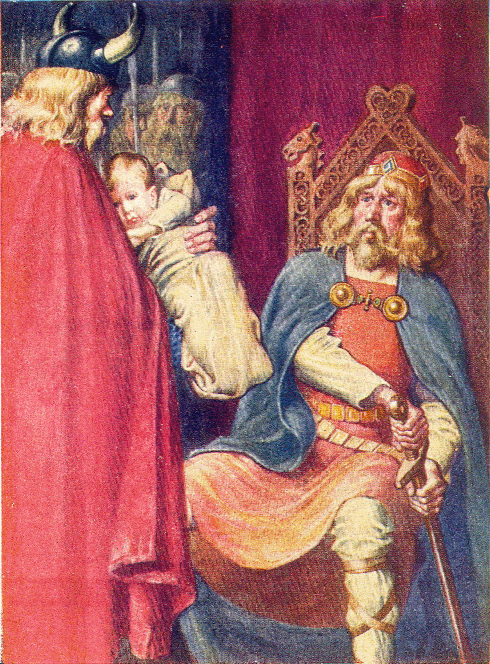Knésetja on:
[Wikipedia]
[Google]
[Amazon]
 ''Knésetja'' (lit. "knee-setting"; German ''Kniesetzung'') is the
''Knésetja'' (lit. "knee-setting"; German ''Kniesetzung'') is the
 ''Knésetja'' (lit. "knee-setting"; German ''Kniesetzung'') is the
''Knésetja'' (lit. "knee-setting"; German ''Kniesetzung'') is the Old Norse
Old Norse, Old Nordic, or Old Scandinavian, is a stage of development of North Germanic dialects before their final divergence into separate Nordic languages. Old Norse was spoken by inhabitants of Scandinavia and their overseas settlemen ...
expression for a custom in Germanic law
Germanic law is a scholarly term used to described a series of commonalities between the various law codes (the ''Leges Barbarorum'', 'laws of the barbarians', also called Leges) of the early Germanic peoples. These were compared with statements ...
, by which adoption was formally expressed by setting the fosterchild on the knees of the foster-father.
Germanic law
When prince Haakon, the youngest son ofHarald Fairhair
Harald Fairhair no, Harald hårfagre Modern Icelandic: ( – ) was a Norwegian king. According to traditions current in Norway and Iceland in the eleventh and twelfth centuries, he reigned from 872 to 930 and was the first King of Nor ...
was brought to the court of Æthelstan
Æthelstan or Athelstan (; ang, Æðelstān ; on, Aðalsteinn; ; – 27 October 939) was King of the Anglo-Saxons from 924 to 927 and King of the English from 927 to his death in 939. He was the son of King Edward the Elder and his fir ...
, the Norwegian messenger, Haukur, simply placed the child on the king's knees as soon as he came into his presence. By this act, Haakon had been adopted by Aethelstan, which also implied an insult to the English king as the foster-father was usually of lower standing than the real father.
Aethelstan became angry and wanted to kill the child on the spot, but Haukur simply said that since he was now the child's foster-father it was up to him whether he wanted to kill him and went away. Aethelstan let the child live and had him baptized. (''Heimskringla
''Heimskringla'' () is the best known of the Old Norse kings' sagas. It was written in Old Norse in Iceland by the poet and historian Snorre Sturlason (1178/79–1241) 1230. The name ''Heimskringla'' was first used in the 17th century, derive ...
'', Harald Harfager's Saga).
The same gesture was also part of the formal ceremony of both engagement and marriage in early Scandinavian law. Here, the bride was set on the knees of the groom.
Indo-European parallels
The Germanic procedure of ''Kniesetzung'' has parallels in various other Indo-European cultures, and has been suggested to derive from a custom inProto-Indo-European society
Proto-Indo-European society is the reconstructed culture of Proto-Indo-Europeans, the ancient speakers of the Proto-Indo-European language, ancestor of all modern Indo-European languages.
Scientific approaches
Many of the modern ideas in this ...
in comparative philology
Comparative linguistics, or comparative-historical linguistics (formerly comparative philology) is a branch of historical linguistics that is concerned with comparing languages to establish their historical relatedness.
Genetic relatedness ...
since the 1920s, although evidence for this is considered inconclusive.
In Hittite texts The corpus of texts written in the Hittite language is indexed by the ''Catalogue des Textes Hittites'' (CTH, since 1971). The catalogue is only a classification of texts; it does not give the texts. One traditionally cites texts by their numbers in ...
of the Late Bronze Age
The Bronze Age is a historic period, lasting approximately from 3300 BC to 1200 BC, characterized by the use of bronze, the presence of writing in some areas, and other early features of urban civilization. The Bronze Age is the second prin ...
, specifically the mythological texts of the ''Song of Ullikummi __NOTOC__
In Hurrian mythology, Ullikummi is a giant stone monster, son of Kumarbi and the sea god's daughter, Sertapsuruhi, or a female cliff. The language of the literary myth in its existing redaction is Hittite, in cuneiform texts recovered a ...
'' and the ''Story of Appu The ''Story of Appu'' is a mythological Hittite text (CTH 360). The text is fragmentary, and the sequence of events in the story is a reconstruction.
The text is usually taken as an account of a Hurrian myth, but it does not itself contain any H ...
'', there are accounts of how, after the birth of the son, the father accepts the newborn from the midwife and as a sign of the son's legitimacy sets him on his knee and names him.
Antoine Meillet suggested that Latin ''genuīnus'' "innate, native; genuine" is a derivation of ''genū'' "knee".
Homer
Homer (; grc, Ὅμηρος , ''Hómēros'') (born ) was a Greek poet who is credited as the author of the ''Iliad'' and the ''Odyssey'', two epic poems that are foundational works of ancient Greek literature. Homer is considered one of the ...
mentions setting on the knee in ''Iliad
The ''Iliad'' (; grc, Ἰλιάς, Iliás, ; "a poem about Ilium") is one of two major ancient Greek epic poems attributed to Homer. It is one of the oldest extant works of literature still widely read by modern audiences. As with the '' Odys ...
'' 9.454 and ''Odyssey
The ''Odyssey'' (; grc, Ὀδύσσεια, Odýsseia, ) is one of two major ancient Greek epic poems attributed to Homer. It is one of the oldest extant works of literature still widely read by modern audiences. As with the ''Iliad'', th ...
'' 19.400.
Comparable customs have been suggested for Indo-Iranian and CelticJ. Loth, Revue Celtique 40 (1923) cultures.
References
*"Adoption" in Eduard Hoffmann-Krayer, Hanns Baechtold-Staeubli (eds.), ''Handwoerterbuch des Deutschen Aberglaubens'', Walter de Gruyter, 1974, . *F. Roeder, ''Die "Schoss" odor "Kniesetzung", eine angelsächsische Verlobungszeremonie'', Göttingen, 1907. {{DEFAULTSORT:Knesetja Early Germanic law Adoption history Gestures Children in early Germanic culture